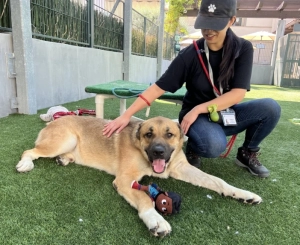Losing pets can be scary, but here are some steps to take to find them

Teddy (A504270) was found lost in the streets, and no owner has stepped forward to claim him. Just like his namesake, Teddy is one of the most lovable fluffs around. Despite his large size (115 lbs!), he’s incredibly sweet and gentle. He walks nicely on a leash, sweetly presses his head into volunteers’ hands for pats, and politely takes treats. If you’re looking for a big Teddy Bear with an even bigger heart, look no further than this gentle soul. Teddy is available for a 14-day adoption trial. More information, pasadenahumane.org/adopt.
Usually, Sueshi greets me at the door with barks of glee and lots of tail wagging, spinning in circles. She was noticeably absent and didn’t respond to my frantic calls as I searched the house for her. So, I locked the door, ran back to the car, and started driving around the neighborhood calling her name and alerting all the neighbors.
Guess who came out from hiding under a chair when I returned home? I like to imagine Sueshi had quite the unsupervised adventure earlier, wandering the neighborhood rolling in mulch and eating any tasty morsel she could find, but soon realized what a great life she has and came back home on her own while the door was still open. It was a good reminder to us to always be super careful and to get that sticky door lock fixed.

Teddy (A504270) was found lost in the streets, and no owner has stepped forward to claim him. Just like his namesake, Teddy is one of the most lovable fluffs around. Despite his large size (115 lbs!), he’s incredibly sweet and gentle. He walks nicely on a leash, sweetly presses his head into volunteers’ hands for pats, and politely takes treats. If you’re looking for a big Teddy Bear with an even bigger heart, look no further than this gentle soul. Teddy is available for a 14-day adoption trial. Learn more at pasadenahumane.org/adopt.
The majority of the dogs that come into our shelter each month are found stray. We presume most stray dogs come from a home, but only about half of lost dogs that enter the shelter reunite with their owners. While our “return to owner” numbers are above the state and national averages, it still saddens me thinking of all the pets and former owners who will never see each other again.
Identification is the best way to ensure that a lost pet gets back home. Make sure your pet always wears a collar with a current ID tag and license. A microchip is another excellent form of identification that your pet cannot lose.
Our animal control officers are equipped with microchip scanners and can reunite lost pets with their owners, rather than bringing them to the shelter, if the contact information is up-to-date.
If your pet goes missing, it’s essential to start your search as soon as possible. Most lost pets don’t wander far from home.
I recommend a dual approach: search your local shelters and connect with neighbors. Some finders will bring a found pet to a local shelter, while others opt to keep the pet in their home while searching for its owner.
Here are some tips to help you find your pet
- Search Shelter Websites: Most shelters, including Pasadena Humane, post regularly updated photo listings of the animals in their care. Check all local shelters, as pets may cross city lines or be taken to a shelter outside of your area
- Post on Social Media: As soon as you notice your pet is missing, post a photo and description of your pet on your local Facebook neighborhood groups and on Nextdoor and search for “lost pet” posts.
- Online Listings: Notify your community’s Rescue Squad by creating a Pawboost alert for your pet. Upload a photo of your pet on Petco Love Lost, an online tool using facial recognition technology.
- Hang Flyers: Create a lost-pet flyer with your pet’s photo and description.
- Search Party: Walk the neighborhood calling for your pet. Ask friendly neighbors to help you. If your lost pet doesn’t turn up immediately, don’t give up. A shy or frightened pet is more likely to hide or be harder to catch. File a lost report at your local shelter and continue to check shelter websites and social media.
At Pasadena Humane, our Animal Resource Center team works to reunite lost and found pets with their owners seven days a week. And this month, we are participating in Maddie’s Fund Return to Home challenge, a national pet reunification initiative with the goal of getting more lost pets back home.
For more lost and found pet tips, pasadenahumane.org/lost-and-found.
Dia DuVernet is president and CEO of Pasadena Humane.
This blog post originally appeared as a column in the Pasadena Star-News on October 21, 2022.


